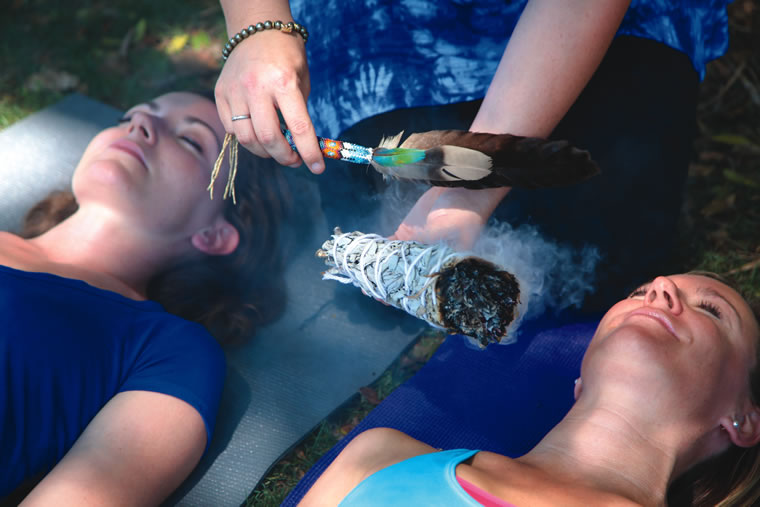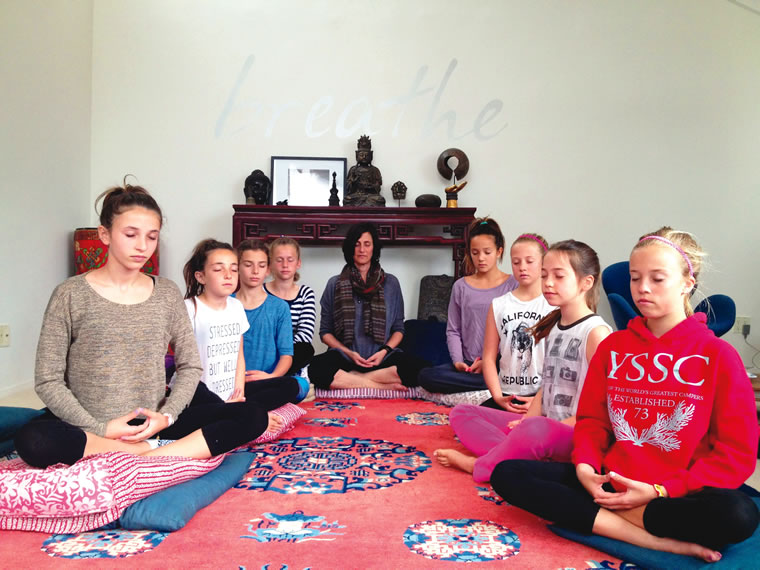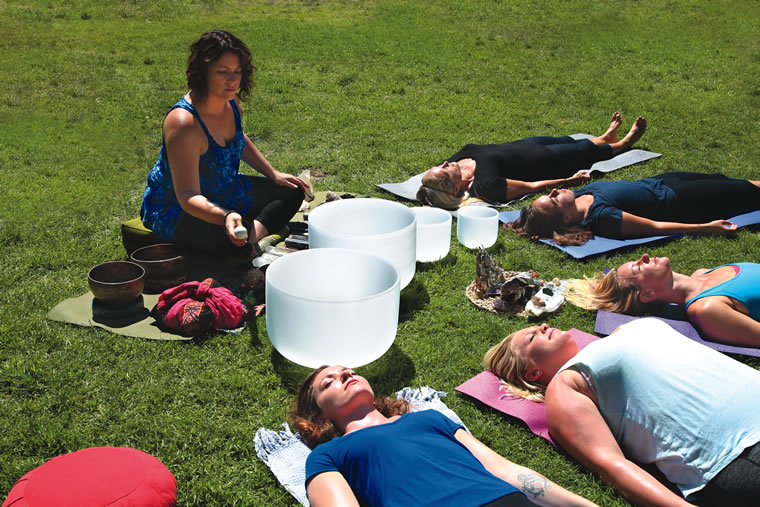Benefits of a Break

While meditation is not a cure for any specific ailment, it’s been proven effective for those who practice regularly. A recent study from UCLA found that meditation can actually help preserve brain tissue that contains neurons (which naturally decreases with age), therefore minimizing the risk of mental illness and neurodegenerative disorders.
“The benefits of meditation have been studied scientifically for the last 100 years in the medical world and for more than 2,000 years in the spiritual world,” says the Rev. Melissa Wallace, owner of Universal Core Wellness Center LLC. “Meditation … sends out an overall healing signal to the body, causing the brain to go into active rest.”
Stress is classified as a contributor to nearly all the major modern-day ailments, and reducing it is one of the main benefits of meditation. A regular practice also lessens the effects of trauma, boosts productivity, lessens depression and anxiety, and positively impacts the neuroplasticity of the brain. Additionally, regular practitioners may experience a reduction in blood pressure and cortisol levels.
“The benefits of meditation have been studied scientifically for the last 100 years in the medical world and for more than 2,000 years in the spiritual world.” -Rev. Melissa Wallace
A two-time cancer survivor, Melissa became involved with meditation as a way to reduce the stress and anxiety of her diagnoses and treatments. “I added meditation to my own healing as one more tool in the toolbox without using a medical prescription,” says Melissa, who is also a holistic health practitioner with a professional background in neurology.
Karen Redding, a Laguna-based clinical social worker and psychoanalyst, says meditation triggers our nervous systems to work in a different way and steadies the mind during the stresses of life. “We’re able to notice that we are catastrophizing and can then stop,” she explains. “We’re able to be more present with what is here rather than reacting to what we think is or could be here.”
Picking Your Path

The benefits of meditation are seemingly endless and, according to Karen, there’s no right or wrong way to do it. “Even the simplest form of meditation allows us to look at the process of our mind and helps people to calm the mania to get to the root of a problem,” she says. “Research has even shown that changes in the brain can be recorded just weeks after a person begins a regular meditation practice.”
Since any type of meditation is likely to have a positive impact, choose a practice to suit your personal preference, or experiment with multiple. “Meditation is a self-taught, adaptive practice,” Lori explains. “No matter what kind of meditation you try, you’ll notice similarities in the anchor points, like noticing the breath.”
Some of the broad forms of meditation acknowledged worldwide include transcendental, Zen, vipassana and mindfulness. In each, the end objective is to teach the mind to quiet, and free it of outside stressors.
While all are beneficial, there are differences between the major varieties. For example, Zen meditation is the practice of sitting in various prescribed positions to relax the body and mind and discover personal insight. Vipassana meditation, taught thousands of years ago by Buddha and practiced now by people of various cultures and backgrounds, teaches people to see things clearly, liberating themselves from suffering. Mindfulness meditation allows a person to sit in the present moment, with no objective or goal, to simply achieve peace with oneself. Transcendental meditation focuses on achieving enlightenment, but can also look to astral projection.
“Regardless of the type of meditation you practice, to learn to meditate and to learn to steady your mind requires you to figure out how to be kind and compassionate with yourself,” Karen says. “Meditation is a practice—a skill that we learn—and no matter what type of practice you try first, it all starts with a person’s intention to clear their mind and create a relationship with what we have going on in life with compassion and nutur[ing].”
Getting Started

Beginning a new practice solo can still be intimidating (or just downright confusing). For an introduction, it can be helpful to follow an experienced practitioner’s lead. Meditating with others also creates a healing space for all of the people practicing together.
“A guided meditation is always a great place to start,” Melissa explains. “Especially in a classroom environment, you learn that everyone and their processes are different. Guided meditation gives you grounding and a focal point to begin your practice.”
Whether you go it alone or with a group, it’s easier to start with short amounts of time. Lori recommends taking it slowly, allocating three minutes to count your breath while noticing when the mind wanders, then moving to six minutes and longer. “By noticing and acknowledging what you have observed during that time, you’re beginning to meditate,” Lori explains.
Karen also suggests easing into the practice. “You may begin with just five minutes of meditation a day while you’re walking, sitting, standing or lying down,” Karen explains. “Whether you use a guided meditation class or application, there are many ways to get inspiration for a daily practice. You don’t need equipment or workout clothes, you just need to make it a conscious part of your day.”
Practice Makes Perfect

A number of factors contribute to the meditative experience, and nearly all can be adjusted to suit your personal goals and preferences. Many imagine meditating in a silent, sedentary state, but you can also practice with a light form of music or binaural beats (measured change in brain activity in response to audio stimulus—different tones played in each ear) as background. Chanting is another way to enhance the experience.
For those who have trouble sitting still for periods of time, an active approach may feel more natural. Try meditating while walking on the beach, or during yoga or tai chi.
“There are so many ways to practice meditation and it takes little effort to begin,” Melissa says. “Surfers feel the healing, natural effects of the water as they ride the waves. This is meditative in that the water simulates the womb and returning to source. Yogis practice active meditation and incorporate movement. However, you can also just sit or lie quietly alone, clearing your mind and opening yourself.”
Whichever approach you take, remember that you can always make alterations later as your skills develop and preferences change. “When first beginning to learn to meditate, the practice can be oversimplified and then built upon,” Lori says. “Beginners come to meditation to initially address stress that’s happening right now, but eventually, we learn to take our meditation practice to the stress in our lives and help alleviate it by taking our awareness into action.”
– Written by Tanya A. Yacina




